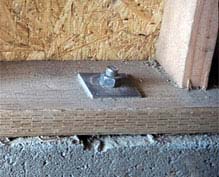by John Eberhard
 Every web site owner would like to increase the amount of traffic to his or her site. I have been pushing the idea for a year or so that creating a blog, and then posting content to it on a regular basis, drives traffic to your web site. But I find that even people for whom I have created and set up blogs don’t get how or why this happens. So I am devoting this entire article to explaining how this works.
Every web site owner would like to increase the amount of traffic to his or her site. I have been pushing the idea for a year or so that creating a blog, and then posting content to it on a regular basis, drives traffic to your web site. But I find that even people for whom I have created and set up blogs don’t get how or why this happens. So I am devoting this entire article to explaining how this works.
First of all, a blog is a special type of web site that makes it easy for you to add new content on a regular basis. New content gets added at the top, and you scroll down to see the older content. It also allows visitors to leave comments, and older content gets automatically archived.
Wordpress is one of the most common blogging systems, allowing you to put up a blog within your web site, as a subfolder (http://www.yourwebsite.com/blog). Typepad is another common blogging system, allowing you to either having it set up under Typepad’s URL (http://yourblogname.typepad.com) or you can set up a separate web address for the blog (http://www.yourblogname.com). Typepad charges a monthly fee.
There are also several free blogging sites, where you can set up a blog, such as Blogger.com and Tumblr.com, and then your blog URL is something like http://yourblogname.blogspot.com or http://yourblogname.tumblr.com. But these sites are much more limited in the features and design templates you can use. In other words, it’s much harder to customize the blog to your needs than with Wordpress or Typepad.
Blog design: When setting up a blog it is wise to design it with one or two sidebars, then add your contact information, and several links to features on your main web site. For example you could link to your home page, your “about us” page, your services page, and so on. If you sell any items such as books you can put an ad for the book in one of the sidebars. You want to set up the blog in such a way that as many people as possible who come to the blog also go over to your web site.
OK, now your blog is set up, with contact info and links to your main web site and all that. Now what?
Now, you put new content up on your blog regularly. By regularly, ideally I mean once a week or more often. Content can be anything from a long article (700-1,000 words), to a press release, to a shorter post or comment about something related to the topic of your blog (100-200 words). You can also post a link to some other content on some other web site or blog that you found that you want to tell your readers about. You can also post a video right in your blog, by taking the code that appears to the right of a video on YouTube.
OK, now there’s new content on the blog. So how is that going to drive traffic? Just putting up new content is going to drive people to the blog, right?
Well normally that would be true, but in the case of blogs that are about 20 search engines that are geared just to blogs. If you notify them, with what is called a “ping,” those search engines will all stop by your blog immediately and include your new article, shorter post, or whatever you put up there, in their search engine listings. There is a site called www.pingomatic.com that allows you to easily send a ping to 22 of these search engines.
This means that if your article was about how to lower your golf score, and someone went to one of these blog search engines and typed in “how to lower your golf score,” and your article contained that phrase, your listing would come up, allowing that person to click through and come to your blog.
So you can see that it is important to include high traffic keywords in your blog posts, and it is important to do some research and find out what the high traffic keywords are for your topic or industry.
So this is all nice theory, but does it really work?
Well I have two blogs for my marketing business, one for articles and a separate one for press releases. I post something to one of the two blogs a minimum of once a week or more. And I always send a ping to all of the blog search engines after every single post.
I checked my Google Analytics statistics for the entire year of 2009 up to today, and my two blogs have generated more traffic to my main web site, than any other source. In fact, if you add them up, it is three times the traffic that I got from Google.
So yes it does work, it is very powerful, and you can do it. But if you do set up a blog, remember, you have to post to it once a week, to get regular benefit and build up momentum. Good luck.
Posted via web from Realwebmarketing's posterous
 SACRAMENTO, CA: Aero & Marine Tax Professionals (http://www.aeromarinetaxpros.com) has obtained a sales and use tax exemption from the California Board of Equalization for their client, Rainbow Sandals, of San Clemente, CA in regards to their purchase of an aircraft for the business. Aero & Marine Tax Professionals are the pre-eminent experts in helping purchasers of aircraft and vessels to avoid paying sales and use tax in California and Arizona.
SACRAMENTO, CA: Aero & Marine Tax Professionals (http://www.aeromarinetaxpros.com) has obtained a sales and use tax exemption from the California Board of Equalization for their client, Rainbow Sandals, of San Clemente, CA in regards to their purchase of an aircraft for the business. Aero & Marine Tax Professionals are the pre-eminent experts in helping purchasers of aircraft and vessels to avoid paying sales and use tax in California and Arizona.
 Google has stated that its main criteria for how high your site will rank in their search engine, is the number of links to your site from other websites. So that means one important activity for any website owner is
Google has stated that its main criteria for how high your site will rank in their search engine, is the number of links to your site from other websites. So that means one important activity for any website owner is 
 Campaign to Include Pay Per Click, Blogs, Article Directories, Optimized Press Releases & Social Media
Campaign to Include Pay Per Click, Blogs, Article Directories, Optimized Press Releases & Social Media Every web site owner would like to increase the amount of traffic to his or her site. I have been pushing the idea for a year or so that creating a blog, and then posting content to it on a regular basis, drives traffic to your web site. But I find that even people for whom I have created and set up blogs don’t get how or why this happens. So I am devoting this entire article to explaining how this works.
Every web site owner would like to increase the amount of traffic to his or her site. I have been pushing the idea for a year or so that creating a blog, and then posting content to it on a regular basis, drives traffic to your web site. But I find that even people for whom I have created and set up blogs don’t get how or why this happens. So I am devoting this entire article to explaining how this works. Link building
Link building Link building
Link building Julian Construction (
Julian Construction (
